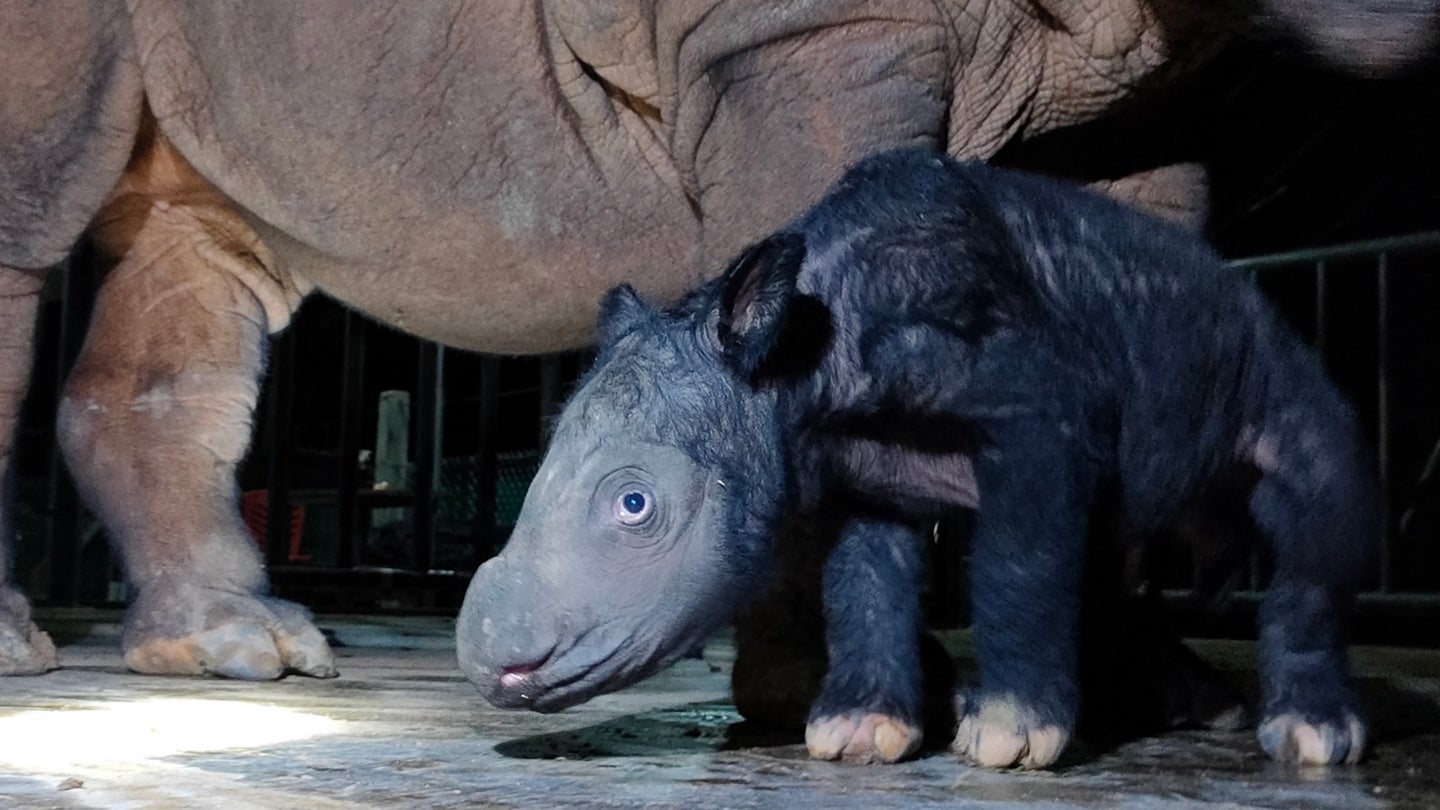A critically endangered Sumatran rhino named Delilah welcomes first calf
The species is critically endangered, with fewer than 50 animals left.

On November 25, a healthy male Sumatran rhinoceros was born at a western Indonesian sanctuary. This birth is welcome news for the critically endangered species. There are less than 50 Sumatran rhinos left, according to the World Wildlife Fund (WWF) and the International Union for Conservation of Nature (IUCN).
[Related: Rhino horns are shrinking, and humans are to blame.]
A seven-year-old female rhino named Delilah gave birth to the 55 pound calf at the Sumatran Rhino Sanctuary in Way Kambas National Park (SRS TNWK) on the island of Sumatra. According to officials from the sanctuary, a conservation guard found her laying next to her calf early on Saturday morning. The birth was about 10 days before the baby’s expected due date. The baby’s father is a rhino named Harapan who was born at the Cincinnati Zoo and Botanical Garden in Ohio before coming to Sumatra.
“You never know if a first-time mom will know what to do, but Delilah brought that calf into the world and started nursing it with no fuss or fanfare. It’s an incredible event that gives hope to the future of this critically endangered species,” International Rhino Foundation executive director Nina Fascione said in a press release.

Sumatran rhinos are the smallest of all rhino species at about 1,000 to 2,100 pounds and three to four feet tall. They have two horns that are dark gray to black. The horns are usually very smooth and form a slender cone that is curved backwards in the wild. Poaching, illegal trading of rhino horns, and climate change have pushed these mammals to the brink of extinction. According to the IUCN Red List, they are currently extinct in Bangladesh, Bhutan, Brunei, Cambodia, India, Laos, Malaysia, Thailand, and Vietnam, according to the Red List. It is uncertain if they are still present in Myanmar.
Successful births like this one are also rare. In 2012, a male rhino named Andatu born at Way Kambas became the first Sumatran rhino born in an Indonesian sanctuary in over 120 years.
“Two years ago there was only one captive Sumatran rhino pair in the world able to successfully produce offspring. Now there are three pairs–six rhinos–who are proven breeders. Those are much better odds for the long-term survival of this species,” said Fascione.
According to Indonesian Environment and Forestry Minister Siti Nurbaya Bakar, this still-to-be-named calf is the fifth born under a semi-wild breeding program at the park. The new addition brings the rhino herd at Way Kambas up to 10 animals and follows the birth of another calf in September.
[Related: Rhinos pay a painful price for oxpecker protection.]
The sanctuary is part of a special zone in the national park where all of the rhinos are protected and looked after by local experts.
“The main objective is to produce Sumatran rhino calves to maintain the survival of the Sumatran rhino species which is now threatened with extinction,” sanctuary Director General of Natural Resources and Ecosystem Conservation Satyawan Pudyatmoko said in a statement. “The Sumatran rhino calves are the result of a breeding program. In the future, at SRS TNWK they can be released back into their natural habitat.”
Veterinarians from the Rhino Foundation of Indonesia (Yayasan Badak Indonesia) and animal care staff will continue to closely monitor Delialah and her new calf as they bond.
